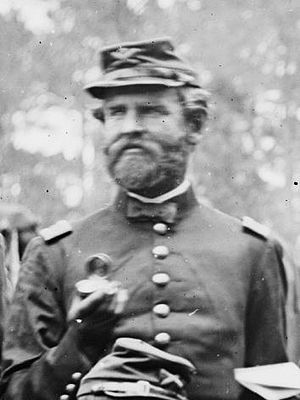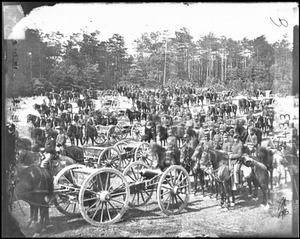Henry Benson (soldier) facts for kids
Quick facts for kids
Henry Benson
|
|
|---|---|
 |
|
| Born | November 20, 1824 Belleville, New Jersey |
| Died | August 11, 1862 (aged 37) |
| Place of burial | |
| Allegiance | Union |
| Service/ |
Union Army |
| Years of service | 1845–1862 |
| Rank | |
| Unit | 2nd U.S. Artillery |
| Commands held | Battery E, 2nd U.S. Artillery Battery M, 2nd U.S. Artillery |
| Battles/wars | Mexican–American War Third Seminole War American Civil War
|
Henry Benson (born November 20, 1824 – died August 11, 1862) was a brave officer in the United States Army. He was an artillery expert, meaning he knew a lot about cannons and big guns. Benson fought in three important wars: the Mexican–American War, the Third Seminole War, and the American Civil War. He was badly hurt in a battle at Malvern Hill on August 5, 1862. He passed away a few days later, on August 11, while on a ship called the S.R. Spaulding.
Contents
Henry Benson's Early Life and Military Start
Henry Benson was born in Belleville, New Jersey. He joined the United States Army on June 6, 1845.
Serving in the Mexican-American War
Benson fought in the Mexican–American War. He was recognized for his "good qualities" and promoted to second lieutenant on June 28, 1848. This promotion became permanent in January 1849. He led a group of artillery soldiers under famous generals like Zachary Taylor and Winfield Scott. He was part of the siege of Mexico City. On March 2, 1853, he was promoted again to first lieutenant.
Adventures in Florida: The Third Seminole War
In 1854, Lieutenant Benson was stationed in Florida. The Army's job there was to map the state, build roads, protect settlers, and move the Seminole tribe. These actions led to the Third Seminole War (1855-1858).
Benson played a big part in mapping Florida. He actively scouted new road paths. He spent time at places like Fort Myers, Fort Meade, Fort Thompson, and Fort Center. When he arrived at Fort Center in April 1855, he wrote about how unpleasant it was. He mentioned "Mosquitos awful. 1,000,000,000 of them….Hot– hot as fire all day."
In 1856, Benson became the commander of the 2nd Artillery, Battery E. On August 2, 1856, his unit fought the Seminoles at Punta Rassa. This battle marked the end of the 2nd Regiment of Artillery's time in Florida. By the end of that year, all units moved back north to Fort Hamilton, New York.
Other Assignments Before the Civil War
In 1857, Battery E was sent to Kansas to help calm down the fighting known as unrest. They were based at Fort Leavenworth.
In 1860, Battery E was moved to Augusta, Georgia.
Henry Benson in the Civil War
When the Civil War began, Lieutenant Benson was with the 2nd Artillery, Battery C. They were stationed at Fort Independence, Massachusetts. In January 1861, Benson's unit moved to Fort Jefferson, Florida. This move was to help prepare for war after Florida left the Union. Benson was key in moving heavy cannons from Fort Taylor to arm Fort Jefferson. This fort was called "the key of the Gulf."
In April, the 2nd Artillery, Battery M arrived in Florida. This unit had been in Fort Brown, Texas in April 1860. They barely escaped capture by Confederate forces at the start of the war in April 1861. They fled to Union lines and then helped at Fort Pickens, Florida.
Benson joined Battery M between January and May 1861. Both units then returned north to join the Virginia campaign in June. He was promoted to captain on May 14, 1861. He took over from Captain Henry Jackson Hunt as commander of Battery M.
Battery M fought in the First Battle of Bull Run in July 1861. Soon after, Major Henry J. Hunt, the previous commander, was promoted. Benson then took full command of Battery M.
In November 1861, Battery M became a horse artillery battery. This meant their cannons could be moved quickly by horses. They were equipped with six 3-inch Ordnance rifles.
In 1862, Battery M moved with the Army of the Potomac into Virginia. This was part of General McClellan's Peninsula Campaign (March–July 1862). Benson led his unit well through several battles. These included the Siege of Yorktown, the Battle of Hanover Court House, and the Battle of Seven Pines.
At Seven Pines, Benson's Battery M had four officers and 109 other soldiers on May 31, 1862. They also had 141 horses and six 3-inch cannons with all their supplies.
General McClellan reportedly thought Captain Benson was one of his favorite officers.
Captain Benson's Death
After General Robert E. Lee pushed back McClellan's attacks on Richmond, Virginia, the Seven Days Battles followed (June 25-July 1, 1862). These battles were very bad for the Army of the Potomac. McClellan refused to attack again from his position at Harrison's Landing without more soldiers. On August 3, 1862, General-in-Chief Henry Halleck ordered McClellan to leave the peninsula. He was to meet up with the Army of Virginia under General John Pope. McClellan did not want to obey this order, but he did nearly two weeks later.
On August 5, 1862, there was another fight at Malvern Hill, Virginia. This was not the same as the earlier Battle of Malvern Hill. In the early morning, Benson's battery fought two groups of Confederate soldiers and their cannons. During the fighting, Benson was badly wounded. A piece of a bursting shell from one of his own cannons broke his leg.
Benson was taken to a hospital ship called the S.R. Spaulding. He was being transported north for medical care. However, he died at sea from his wounds on August 11, 1862. His body was returned to his hometown of Belleville, New Jersey. He was buried in the Belleville Dutch Reformed Churchyard on August 13, 1862.
Henry Benson's Legacy
In 1864, an artillery battery that defended Washington, D.C. was named Battery Henry Benson.
Later, in 1904, a coast artillery battery at Fort Worden was also named after Benson. This was part of the Endicott Era defenses.
A street in his hometown of Belleville, New Jersey, is also named in his honor.



